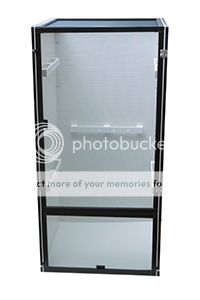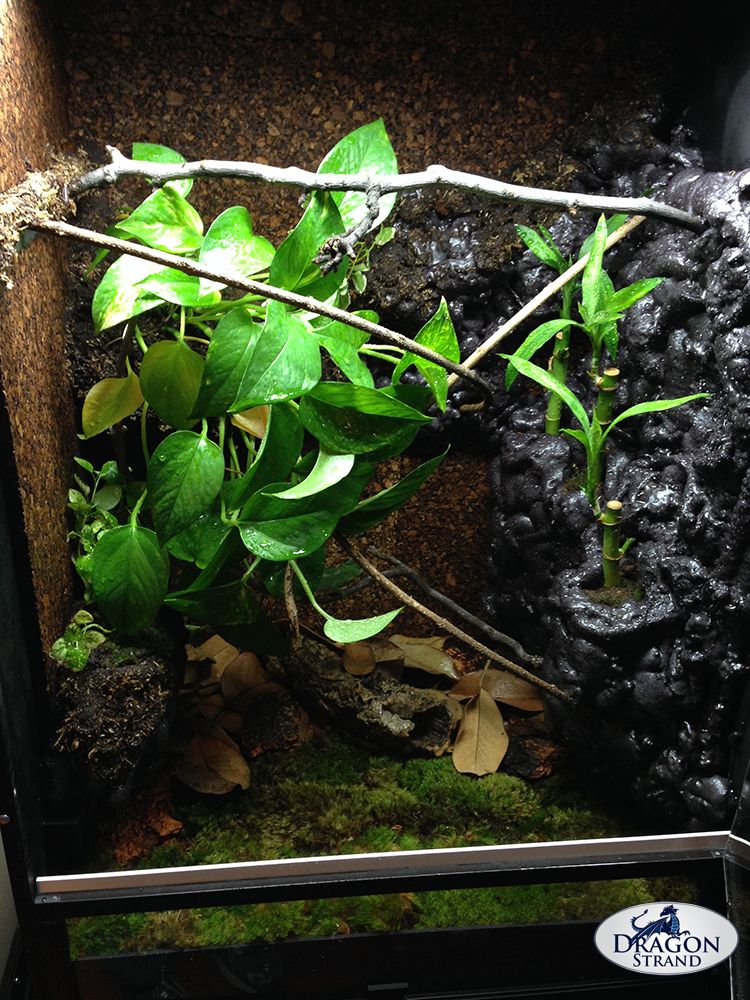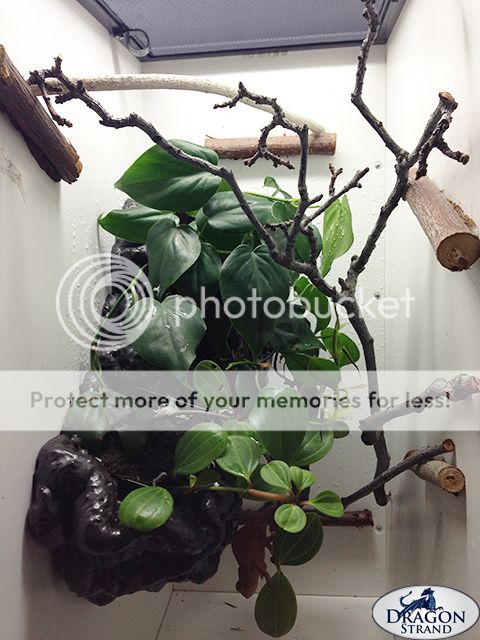Have you ever wanted to have that hanging plant up high in your chameleon enclosure? With the traditional screen cages we have had to exercise creativity to just put in a horizontal branch, much less hang a nice leafy pothos where it can trail down the side of the cage! I'd like to propose that more of the chameleon community give a deeper level of naturalistic vivaria a try. There is nothing wrong with the screen cages and that is a fine choice! But there are a couple different levels to consider. Many advanced keepers already have naturalistic set-ups. In this blog series I’d like to introduce us to different levels of more and more naturalistic set-ups. Each has its pros and cons. The important thing is knowing the pros and cons and making the decision which is right for you.
This series will center around the Dragon Strand Breeder Series cages. I designed these cages to allow myself more possibilities in my caging and will use this blog to share my explorations. The cages depicted here are available at the Dragonstrand.com website if you wish to try these environments out for yourself.

The major characteristics of the Breeder series cage that are important to what we are doing here are as follows:

1) Solid sides: The screen front and top give the necessary ventilation. The solid sides give visual isolation and keeps the mist inside the cage. The visual isolation works both ways. First, it allows multiple chameleons to be kept in the same room without stress from interaction and it also allows for the creation of a true hiding spot. (Hiding spots are difficult to create in a 360 degree viewable screen cage.) Keeping the mist inside the cage allows more watering and much less need to keep the watering to one spot in the middle so it does not ruin the furniture. With more freedom to mist the chameleons will be better hydrated and plants will be well watered.

2) Branch Holders: In the adult cages in the Breeder Series there are branch holders on the walls and back. These act as anchors so it is very easy to install horizontal branches. They are also load bearing. This means we can hang things from them. We will take great advantage of this characteristic.

3) Substrate and Drainage Trays: With the availability of Substrate and Drainage trays our options increase. The Drainage Trays go under the cage and catch excess water. The substrate trays go inside the cage and can provide a planter if you desire a living floor. This is often used with pygmy chameleons and can be used with larger chameleons if done wisely. Impaction (eating of substrate) and escaped feeder insects will have to be addressed in some manner, of course.
Why should we go through the trouble of creating a more naturalistic cage? The first reason is for the chameleon. It has not been shown that chameleons know the difference between fake and real branches or plants. But they do have a need for humidity, water drinking surfaces and security. Natural plants can offer these elements if they are at the correct levels and provide enough density. We will go over some designs that will increase the benefit of the plants in your vivarium so you maximize their humidity advantage, bring the water drinking surfaces to the optimal heights in the cage and provide the necessary densities of leaf cover for giving the chameleon cover for security.
The second reason is for us. We are bringing a piece of nature into our homes. Our enjoyment is increased the more beautiful we make that slice of nature. Having the chameleon as the most beautiful piece of the set-up is usual as it is usually the focus. But consider if the set-up was just as beautiful as the chameleon. This is certainly worth considering.
This is what is possible with a Medium Wide Breeder Cage:

In this blog series I will review different possibilities for these Breeder Series cages. One certainly does not have to go all the way as the picture above. There are a number of intermediary steps which add both functionality and beauty to a cage over the standard screen set-up. Take this set-up below with a Compact Cage.

It simply adds a planter half way up the side of the cage. Humidity is increased and an effective hiding spot is created (notice the juvenile pardalis hanging out below the planter). Drinking surfaces are available at multiple heights.
In my next entry I will introduce you to the materials and skills needed to make these interiors yourself. We’ll start with the simple one above that just has a planter. From this we can practice from the ground floor. The entry after that will be a cage with an added level of complexity and so on. We’ll end with the very beautiful naturalistic environment which combines all the skills we will go over. By the end of this I will be very interested to see what your creativity has led to!
(And, yes, one of the projects we will review will be a chameleon/carnivorous plant combination. You knew that had to happen.)
Happy Chameleon Wrangling!
Bill from Dragon Strand
To learn more about the caging shown here go to www.dragonstrand.com and like us on Facebook at www.facebook.com/dragonstrand
This series will center around the Dragon Strand Breeder Series cages. I designed these cages to allow myself more possibilities in my caging and will use this blog to share my explorations. The cages depicted here are available at the Dragonstrand.com website if you wish to try these environments out for yourself.

The major characteristics of the Breeder series cage that are important to what we are doing here are as follows:

1) Solid sides: The screen front and top give the necessary ventilation. The solid sides give visual isolation and keeps the mist inside the cage. The visual isolation works both ways. First, it allows multiple chameleons to be kept in the same room without stress from interaction and it also allows for the creation of a true hiding spot. (Hiding spots are difficult to create in a 360 degree viewable screen cage.) Keeping the mist inside the cage allows more watering and much less need to keep the watering to one spot in the middle so it does not ruin the furniture. With more freedom to mist the chameleons will be better hydrated and plants will be well watered.
2) Branch Holders: In the adult cages in the Breeder Series there are branch holders on the walls and back. These act as anchors so it is very easy to install horizontal branches. They are also load bearing. This means we can hang things from them. We will take great advantage of this characteristic.

3) Substrate and Drainage Trays: With the availability of Substrate and Drainage trays our options increase. The Drainage Trays go under the cage and catch excess water. The substrate trays go inside the cage and can provide a planter if you desire a living floor. This is often used with pygmy chameleons and can be used with larger chameleons if done wisely. Impaction (eating of substrate) and escaped feeder insects will have to be addressed in some manner, of course.
Why should we go through the trouble of creating a more naturalistic cage? The first reason is for the chameleon. It has not been shown that chameleons know the difference between fake and real branches or plants. But they do have a need for humidity, water drinking surfaces and security. Natural plants can offer these elements if they are at the correct levels and provide enough density. We will go over some designs that will increase the benefit of the plants in your vivarium so you maximize their humidity advantage, bring the water drinking surfaces to the optimal heights in the cage and provide the necessary densities of leaf cover for giving the chameleon cover for security.
The second reason is for us. We are bringing a piece of nature into our homes. Our enjoyment is increased the more beautiful we make that slice of nature. Having the chameleon as the most beautiful piece of the set-up is usual as it is usually the focus. But consider if the set-up was just as beautiful as the chameleon. This is certainly worth considering.
This is what is possible with a Medium Wide Breeder Cage:

In this blog series I will review different possibilities for these Breeder Series cages. One certainly does not have to go all the way as the picture above. There are a number of intermediary steps which add both functionality and beauty to a cage over the standard screen set-up. Take this set-up below with a Compact Cage.

It simply adds a planter half way up the side of the cage. Humidity is increased and an effective hiding spot is created (notice the juvenile pardalis hanging out below the planter). Drinking surfaces are available at multiple heights.
In my next entry I will introduce you to the materials and skills needed to make these interiors yourself. We’ll start with the simple one above that just has a planter. From this we can practice from the ground floor. The entry after that will be a cage with an added level of complexity and so on. We’ll end with the very beautiful naturalistic environment which combines all the skills we will go over. By the end of this I will be very interested to see what your creativity has led to!
(And, yes, one of the projects we will review will be a chameleon/carnivorous plant combination. You knew that had to happen.)
Happy Chameleon Wrangling!
Bill from Dragon Strand
To learn more about the caging shown here go to www.dragonstrand.com and like us on Facebook at www.facebook.com/dragonstrand
